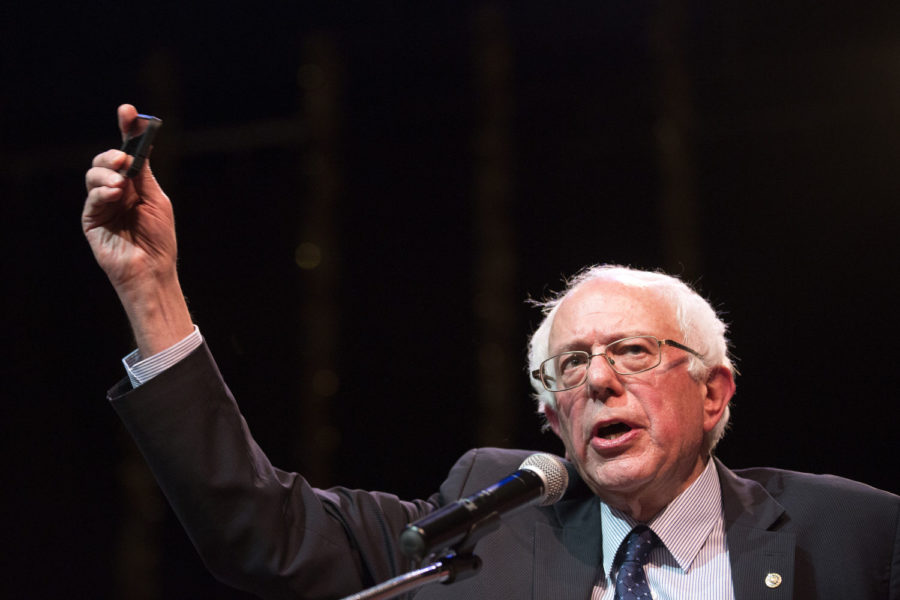Bernie Sanders may not prevail, but his revolution is just getting started
March 18, 2016
Hillary Clinton’s March 15 sweep of Florida, Illinois, Missouri, North Carolina and Ohio effectively slammed the door on the story that would have dominated this presidential primary season were it not for one Donald J. Trump: the rise of Vermont Sen. Bernie Sanders to lead a movement that threatened Clinton’s path to the Democratic nomination.
A self-styled “democratic socialist” and scourge of Wall Street, Sanders has gone much further than anyone anticipated. His ability to inspire the party’s liberal grass roots — which has delivered more than $100 million in financial support along with its loyalty — means that he could conceivably stay in the race all the way until the Democratic convention in July.
But he won’t be the nominee. Clinton’s delegate haul now all but assures that.
Advertisement
Ever since Sanders began drawing massive crowds last summer, pundits have explained his strength as being primarily a product of Clinton’s weaknesses: her trouble attracting young people, her murky ties to wealthy donors and Wall Street, her inability to energize Democratic voters despite what is, after all, an historic candidacy.
At the Democrats’ March 9 debate, Clinton herself seemed to accept this critique when she said plaintively, “I am not a natural politician, in case you haven’t noticed.”
Maybe not. But the true basis of Sanders’s strength has been largely overlooked: He gives voice to a set of policy ideas that lie closer to the hearts of most Democratic voters — and especially the Democratic voters of the future — than Clinton’s do. That’s why the “revolution” he’s repeatedly called for won’t be quelled for long, even though Clinton will be the one accepting the party’s nomination in Philadelphia. This is as much a demographic certainty as a political one.
In their 2002 book, “The Emerging Democratic Majority,” John Judis and Ruy Teixeira predicted that Democrats would enjoy an advantage in national elections because the major demographic groups that make up their coalition (young people, minorities and single white women) were all growing as a percentage of the electorate, while the groups that Republicans rely on (married white people and seniors) weren’t keeping pace.
This proved prescient. In 2008 and then 2012, Barack Obama successfully activated what the journalist Ron Brownstein dubbed the “coalition of the ascendant” to win the White House.
Yet the rise of this new coalition has also had underappreciated policy implications.
“The groups that dominate the party now are different than the ones that dominated 20 years ago — they’re further left,” says Teixeira.
Advertisement*
Indeed, millennials, minorities and single white women all favor a more activist and interventionist government, particularly in the economic realm, than do other Democrats. Consider:
— A 2011 Allstate/National Journal Heartland Monitor study found that black, Latino and Asian voters were twice as likely as white voters to say that government should play “an active role in regulating the marketplace.”
— A 2015 annual survey of college freshmen conducted by the University of California at Los Angeles found that more students identified as “liberal” than at any time since 1973.
— A December Democracy Corps poll found that unmarried white women favor Clinton over Trump by 27 points, while their married counterparts prefer Trump by 12 points.
These groups not only favor more liberal policies, they’re growing impatient for them.
“They’re fed up with the lack of progress,” says Teixeira.
In hindsight, it shouldn’t be quite so surprising that Sanders won more than 80 percent of voters under 30 in Iowa, New Hampshire and Nevada, or that young single women have flocked to him rather than Clinton.
“There’s growing evidence that these groups are open to the boldest possible reforms,” says Democratic pollster Stanley Greenberg. “But they won’t engage unless they think you’re leading from the outside and willing to break down this system in which moneyed interests dominate government.”
Sanders fit the bill.
To her credit, Clinton recognized this shift in the Democratic coalition and moved to accommodate it. She has embraced same-sex marriage, criminal justice reform and tighter Wall Street regulations, while spurning calls to cut entitlement programs — a mainstream Democratic position as recently as a few years ago.
“(You) deserve a president who will protect, and then expand, Social Security for those who need it most, not cut or privatize it,” Clinton declared in her March 15 victory speech.
Most striking, she’s turned against the Trans-Pacific Partnership, a trade deal she helped negotiate as secretary of state.
All this looks as if it will be enough to secure her the nomination. It may not be enough to satisfy Democratic voters under a future Clinton administration.
“Minority voters, unmarried single women — these voters are very open to big policies,” says Greenberg, who lays out his own predictions in a new book, “America Ascendant.
“Whether it’s investment taxes, changing corporate governance, or progressive income taxation, they are supportive of the broadest possible changes.”
The rising Democratic coalition will continue to grow.
Greenberg estimates that 73 percent of likely Democratic voters already belong to this group.
Take millennials, Sanders’s most ardent supporters. Eight years ago, when Obama first ran, many weren’t eligible to vote. This year they’re as large a share of the voting-age population as baby boomers.
By 2020, when a President Clinton would come up for re-election, millennials will easily outnumber them.
The important thing to understand is that Sanders is a vehicle, not the catalyst, for the increasing liberalism of the Democratic electorate. No one should make the mistake of assuming that just because he’ll go away, the agenda he speaks for will, too.
“Sanders isn’t just a flash in the pan,” say Teixeira. “His success indicates something much deeper. For better or for worse, the Democratic Party is a party in flux and moving in a more progressive direction. And if you’re going to lead the party, you ignore those elements of discontent at your peril.”
Joshua Green is a Bloomberg News contributor. Readers may send him email at [email protected].
___
(c)2016 Bloomberg News
Visit Bloomberg News at www.bloomberg.com
Distributed by Tribune Content Agency, LLC.
Advertisement









